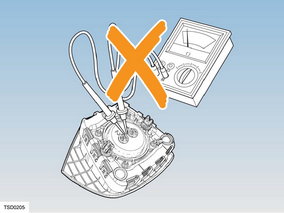Tesla Model S: General Precautions
The supplementary restraint system (SRS) includes air bags, pre-tensioners, and other safety-related components. The SRS contains components which could be potentially hazardous to the technician if not serviced and handled correctly.
Warning: Always follow these precautions and the relevant Service Manual procedures when servicing air bags and other SRS components. Only trained professionals should service the SRS.
Warning: An undeployed air bag module or pre-tensioner contains sodium azide, which is poisonous and extremely flammable. Contact with water, acid or heavy metals might produce harmful or explosive compounds. Do not dismantle, incinerate or bring into contact with electricity, before the unit has been deployed.
Warning: In the event of an air bag or seat belt tensioner deployment, certain air bag and seat belt components must be replaced, and other components must be inspected for damage. Refer to body repair tech note BR-14-20-001 for a specific list of items that must be inspected and replaced.
Warning: Do not expose an air bag module or seat belt pre-tensioner to heat exceeding 85ºC.
These precautions are not restricted to operations performed when servicing the SRS; the same care must be exercised when working on other systems and components located near the SRS components:
- Steering system: Driver's air bag, clockspring.
- Dash: Passenger's air bag, knee air bags.
- Interior trim: Passive Safety Restraint Control Module (PSRCM), Body Control Module (BCM), front seat belt pre-tensioners, curtain air bags.
- Electrical system: Pyrotechnic fuse, SRS harnesses, link leads, connectors.
Before working on, or in the vicinity of, SRS components, perform the following procedures to disable the system:
- Use Toolbox to check for any stored fault codes.
- Perform the vehicle electrical isolation procedure (refer to procedure).
- Wait 1 minute for the energy reserve capacitors to discharge.
Carefully inspect SRS components before installation. Do not install a component if it shows evidence of being dropped or improperly handled, such as dents, cracks or deformation.
Warning:
- Never install used SRS components from another vehicle or attempt to repair an SRS component. Use only new, genuine Tesla replacement parts.
- Never use SRS components that lack clear identification labels.
- Never use a PSRCM that has been dropped.
- Never apply electrical power to an SRS component unless instructed to do so as part of an approved test procedure.
- Always use new fasteners when replacing SRS components. Ensure that the fasteners are tightened to the specified torque.
- Ensure SRS components are not contaminated with oil, grease, detergent or water.
- Ensure the Passive Safety Restraint Control Module (PSRCM) is installed correctly. There must not be any gap between the PSRCM and its mounting bracket. An incorrectly mounted PSRCM might cause the system to malfunction.
- Do not supply power to the PSRCM until all other SRS components are connected.
SRS component testing precautions
The air bags and other SRS components are triggered using relatively low operating currents. To prevent accidental deployment, always adhere to the following precautions:
Warning: Do not use a multi meter or other general purpose test equipment on SRS components. Only use the recommended diagnostic equipment to diagnose system faults.

Handling and storage
Warning:
- The PSRCM, pre-tensioners, and air bags must be stored in a secure steel cabinet at room temperature. The storage area must comply with all legal requirements. It must be away from flammable items and have suitable fire extinguishers or other fire extinguishing equipment. Ensure that heat, fire, water and corrosive substances cannot contaminate the stored components.
- Keep new SRS components in the original packaging until they are ready to be installed.
- Never wrap your arms around an air bag module. If an air bag module has to be carried, hold it by the cover, with the cover face up and the base away from your body.
- When handling seat belt pre-tensioners with retracting spool assemblies, never point the end of the piston tube towards your body or at other people. Hold with the piston pointing towards the ground. Do not grip by the retractor reel or seat belt. Hold the outer casing only.
- Always keep components cool, dry and free from contamination.
- Never transport air bag modules or seat belt pre-tensioners in the cabin of a vehicle.
- Never attach anything to an air bag cover or any trim component covering an air bag module. Do not allow anything to rest on top of an air bag module.
- Do not apply grease or cleaning solvents to seat belt pre-tensioner units. Component failure could result.
- Never drop an air bag or SRS component. The PSRCM is a particularly shock sensitive device and must be handled with extreme care.


SRS Harnesses and Connectors
Note: SRS wiring can be identified by a special yellow outer sleeve protecting the wires (black with yellow stripe protective coverings are sometimes used).
Warning: Never attempt to modify, splice or repair SRS wiring.

Warning: Always ensure that SRS wiring is routed correctly. Be careful to avoid trapping or pinching the cables. Do not leave the connectors hanging loose or allow SRS components to hang from their harnesses. Look for possible points of chafing.



